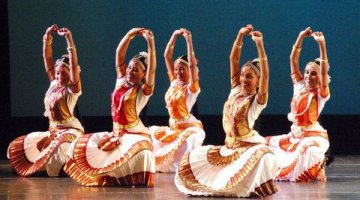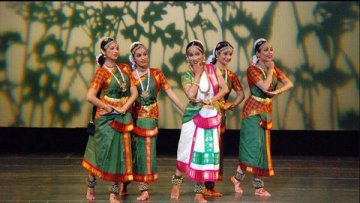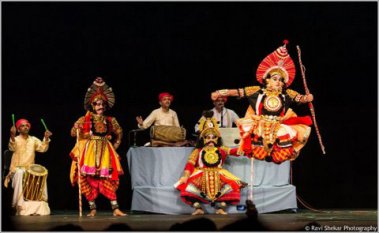
|   |

|   |
Mesmerized by one, two, three many visual extravaganzas - Poornima Ramaprasad e-mail: poornima@sbcglobal.net October 8, 2013 San Francisco bay area is surely the motherland of Indian classical art forms out of India. It is the home away from home for all the artistes. The rasikas of the valley enjoyed a multitude of classy dance programs over two weeks and each was an experience in itself. 

Kala Vandana Dance Company
On September 14, Kala Vandana Dance Company, a premier institution
imparting Bharatanatyam lessons to aspiring youngsters in the
Kalakshetra style, came together for a Fall concert at the Mexican
Heritage Plaza in San Jose. The dancers were all post arangetram
students of Kala Vandana along with Sundara Swaminathan, a fine dancer,
choreographer, teacher and an alumna of Kalakshetra. They performed for a
traditional margam, starting with mallari, followed by a jatiswaram, a
lovely varnam in ragam Naatakuranji followed by lighter items with
abhinaya including a melodious padam in Thillang “Pandadithanale” where
Sundara Swaminathan took the center stage as the maiden Vasanthavalli
and brought a virtual ball on stage with the anxious audience wondering
where it would drop down. The program ended with the grand finale, an
upbeat thillana in Sindhubhairavi to which the whole group came
together.I was very impressed by this high quality program by all these young dancers who have learned dance in a foreign country where there is not much exposure to Indian culture or traditions or mythology outside of home. Choreography by Sundara Swaminathan was subtle and energetic as the item demanded, the execution was seamless and costumes lovely. We need such schools that demand practice, perseverance and quality in their students to save the art form with all its originality, for the generations to come.


Sudhanvaarjuna Kaalaga
On September 21, Kannada Koota of North California celebrated its 40th
anniversary with the event ‘Kannadotsava’ at the Spangenberg auditorium
in Palo Alto. So wrong of a typical September day in San Francisco bay
area, it was raining cats and dogs. Nonetheless, it did not stop the
ardent rasikas from attending this event which featured a wonderful
Yakshagana program ‘Sudhanvaarjuna Kaalaga’ (The war of Sudhanva and
Arjuna) that comes in the Ashwamedha Parva of the Mahabharata. It was by
Purnachandra Yakshakala Prathistana, a famous troupe from Karnataka led
by Kondadakuli Ramachandra Hegade. He is a very sought after Yakshagana
artiste and director in the Badaguthittu style of Yakshagana.
Ramachandra Hegade took the role of Sudhanva and brought the artists
together in a fantastic way culminating in a very lively performance.
The chande drummer and the Bhagavataru were also part of the troupe
leading to a perfect coordination among them. Pics: Ravi Shekar Photography The narrative started with the aftermath of the Pandavas’ victory in the great war. To celebrate their success, they decide to do Ashwamedha Yaga and hence send the horse with all the required lakshanas to every kingdom. If any king opposes and captures the horse, he has to win Arjuna and the Pandavas in the ensuing combat. One fine day, the horse lands at King Hamsadhwaja’s kingdom and Hamsadhwaja sends word to his brave son Sudhanva to fight Arjuna. As Sudhanva sets out on this mission, his consort Prabhavati is very doubtful that he will return safely, so she says that she would want to have a child with Sudhanva, for otherwise, she might be childless. Any amount of convincing on the part of Sudhanva does not do any good and she insists that he make love and that she has to become a mother to fulfill the purpose of her existence. Finally, Sudhanva has to oblige. In the meantime, he is late for the call of duty. This completes the first half. This was done in a very slow pace, establishing the story and setting the mood for Yakshagana. In the action oriented second half, Sudhanva takes the orders of his father Hamsadhwaja. He fights many big and small kings and emerges victorious. Next comes Krishna’s son Pradyumna who is also defeated and then Arjuna himself makes his appearance. A fierce battle ensues between them and Arjuna fails. The defeated Arjuna thinks of Krishna and Krishna appears right before him. Krishna says that Sudhanva is his ardent bhakta and he cannot give him an inglorious defeat and death. However, he says that Sudhanva’s good deeds are not enough to gain him mukti and so he imparts some of his goodness to him and finally beheads him with his chakra and gives him mukti, while being Arjuna’s protector as always. There were some fantastic performances by Sudhanva and Prabhavati with respect to acting and dance. The male artist who enacted Prabhavati and later enacted Arjuna did perfect justice to both the roles. Every actor stepped up to their roles to bring a very vivid show on this landmark anniversary of our local Kannada organization. The heavy makeup added glory to the show. Thanks to KKNC for striving to bring back art forms that are so unfamiliar to most, yet so enriching and enjoyable.


Another mind blowing performance was the musical ‘Sree Lalaama’ depicting the story of Sri Krishna Leela by another visiting troupe from Karnataka led by the Rajyotsava award winner Chandrashekara Navada, who is a well known exponent of Bharatanatyam and Yakshagana in Karnataka. This was hosted under the banner of Natya Ninaada academy of performing arts at the enormous Foothill College auditorium in Los Altos on September 28. The story unfolds with the wedding of Devaki and Vasudeva which was celebrated by Devaki's brother Kamsa. But when he hears an ‘ashareera vaani’ saying that the eighth child born of Devaki and Vasudeva shall be his slayer, he decides to kill them. To Vasudeva's requests, he agrees to keep the newlywed couple under arrest in his prisons and kill any child born out of them and so he does. When the eighth child is born, Vasudeva decides to protect him and on the rainy day with Adishesha as his umbrella, he takes baby Krishna to Nanda Gokula and brings back with him a little girl. Little knowing that the babies were exchanged, Kamsa tries to kill the baby in hand and the baby flies away. So Kamsa gets an inkling that his rival is still alive. He calls upon his sister Putani and tells her to find all babies born in the month of Shravana. The demoness Putani who entered the stage from the audience section looking around trying to do her duty, indeed, leaped into the hearts of the awestruck audience. She then disguises as a lovely damsel and goes to Nanda Gokula, finds Krishna and tries to kill him. When he bites into her breasts, she attains her real form and perishes. All this action was beautifully created on stage by multiple little Krishnas, one with the real demon Putani and the other with the masqueraded beautiful Putani. Furthermore, other incidents from the Bala Kanda including the story of Kalinga the snake, the story of the enchanting Krishna and the gopikas just carried away the audience to Nanda Gokula. Elsewhere in Mathura, Kamsa is well aware that Krishna is growing up somewhere to be a valiant young man and has dreams of Krishna coming and slaying him. This was beautifully presented by all artistes who enacted Krishna at various ages coming together. He then sends the demons Chanura and Mushtikasura, who are experts in combat wrestling who also get crushed by Krishna. Finally Krishna and Balarama arrive at the evil Kamsa's palace and crush him to death. The musical ended with all the dancers coming together for the beautiful shloka: "Vasudeva sutam Devam, Kamsa Chanoora mardanam, Devaki paramaanandam, Krishnam vande Jagatgurum" Chandrashekara Navada as Kamsa enthralled the audience, so did Sneha Vivek as the hag Putani with her spellbinding performance. Every other dancer did perfect justice to their roles and a must mention are three child artistes who were too sweet as little Krishnas. The dance for Kamsa and Putani were in the Yakshagana style and all the other roles were enacted in Bharatanatyam. The costumes were carefully chosen and makeup was very professional for the special characters. The props were simple yet very apt. The music was recorded and the lyrics were in very simple Samskrita that common man could follow. All in all, the Bala Kanda of Krishna came alive in the minds and will stay in the hearts of the rasikas for a long time to come. Where else, but in the bay area, can one conveniently watch three wonderful programs in a span of 2 weeks. Back to my favorite line again, "Life is good in the valley of sand." Poornima Ramaprasad follows Indian classical music and dance forms. She reviews Indian dance and drama events in the San Francisco bay area from time to time. |